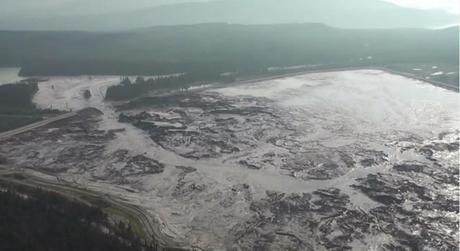
Mount Polley Mine tailings pond breach, Credit: Cariboo Regional District/Screenshot
by Kiley Kroh / Think Progress
Earlier this month, hundreds of Canadians were unable to use their water after 1.3 billion gallons of slurry from an open pit mine in British Columbiaspilled into nearby lakes, rivers and creeks. Now, a B.C. First Nation plans to evict the company, Imperial Metals Corp., over another project on their territory, CBC News reported.
Neskonlith Chief Judy Wilson said she intended to hand-deliver the notice to Imperial Metals on Thursday, directing the company to steer clear of the site of its proposed Ruddock Creek zinc and lead mine. If the mine is approved, it would be located at the headwaters of an important sockeye salmon run.
“We do not want the mine developing or operating in that sacred headwaters,” Wilson told the CBC. “Our elders have stated very clearly that they do not want anything poisoning our water or our salmon.”
While the Neskonlith were opposed to the mine long before the recent spill, Wilson said the incident shows that the mining industry cannot ensure the environment will be protected from their operations. “The industry has proven at Mount Polley that they can’t regulate all of that,” she said.
While water quality tests have deemed the water safe for use and local officials have said the Mount Polley spill won’t damage fish populations in the area, experts say the incident — which resulted in the declaration of a local state of emergency — could still be reason for concern. Megan Thompson, an aquatic ecologist and limnologist at a Canadian environmental consulting firm, told ThinkProgress’ Katie Valentine that there are “many things in the tailings that could impact lakes and rivers, especially if those substances did not naturally occur in the aquatic systems prior to the spill.”
Tailings ponds are used to store a mix of water, chemicals and ground-up minerals left over from mining operations. After the dam failed at Mount Polley, sending 2,000 Olympic swimming pools of waste into the water supply, the focus has been on plugging the dam before rains come to the area and assessing the damage. With 20 other operating mines with similar tailings ponds, the incident served as a wake-up call for officials, Mines Minister Bill Bennett told the Vancouver Sun.
“I am losing sleep over this,” Bennett said. “This gives us about the best reason a person could have to really take a step back. Every Canadian has to be concerned about this.”
The Mount Polley spill also intensified the opposition of First Nations to other mining projects on their land. The Red Chris gold and copper mine in northwest B.C., another Imperial Metals project, has been a divisive issue in the Tahltan First Nation for several years. The mine is located in an unspoiled wilderness near the ‘Sacred Headwaters,’ where three major rivers originate. The Kablona Keepers, a group of Tahltan First Nation members, announced their plan to blockade the mine last week.
“How many years did we fight Imperial and we let them go?” Rhoda Quack, head of the Klabona Keepers, asked the group. “When we talked to them they told us the tailings pond is the same design as Mount Polley and that it works fine. Look at it now. We can’t have that happen here,” she said.

